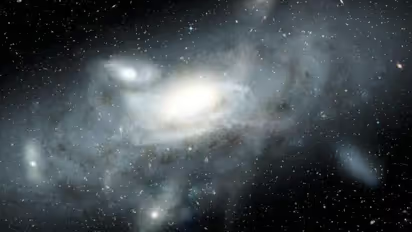A mysterious light has been blinking in space every 21 minutes for 35 years; astronomers clueless

Synopsis
Scientists have discovered two stars emitting mysterious radio waves, exhibiting unusual blinking behavior, raising questions about their nature and potential as a new type of stellar object.
Scientists have made an intriguing discovery involving two stars exhibiting mysterious properties. These celestial objects have been emitting radio waves approximately every 20 minutes. Normally, such repeating signals are associated with pulsars, which are rapidly rotating neutron stars emitting beams of energy akin to lighthouses, causing them to appear as blinking on and off when observed from Earth. However, in this case, the two stars in question spin much more slowly than typical neutron stars, raising curiosity about their nature.
Astronomer Natasha Hurley-Walker of Curtin University in Bentley, Western Australia said, "We are all still quite amazed and intrigued and baffled."
Astronomers first stumbled upon this enigmatic phenomenon in 2021 when they detected a slowly repeating radio pulse in archival data from 2018. The object displayed its blinking behavior for about three months before vanishing from sight in the skies. These peculiar traits prompted scientists to speculate that they may have encountered a rare form of magnetar, which they christened GLEAM-X J162759.5-523504.3. Unlike known magnetars that emit pulses every few seconds, this newfound star sent out its signals every 18 minutes.
Driven by their curiosity, the researchers embarked on a quest to locate similar objects in space. In June 2022, Natasha Hurley-Walker and her team observed the night sky for three nights using the Murchison Widefield Array in Western Australia. To their amazement, they identified another radio flash occurring at regular intervals of 21 minutes. What astonished them further was that archival data revealed this star, dubbed GPM J1839-10, had been exhibiting the same behaviour since at least 1988, a staggering duration of 35 years and counting.
While researchers speculate that both objects may be the same type of star, they are baffled by the divergent patterns of their radio emissions. One flashed for merely three months, while the other has been doing so for decades. The exact reason behind this disparity remains an enigma, leaving astronomers puzzled for now.
The search for answers continues, as the scientific community grapples with the mysteries presented by these two unusual stellar objects. As the astronomers delve deeper into their research, they hope to unravel the secrets behind these stars with perplexing characteristics.
Check the Breaking News Today and Latest News from across India and around the world. Stay updated with the latest World News and global developments from politics to economy and current affairs. Get in-depth coverage of China News, Europe News, Pakistan News, and South Asia News, along with top headlines from the UK and US. Follow expert analysis, international trends, and breaking updates from around the globe. Download the Asianet News Official App from the Android Play Store and iPhone App Store for accurate and timely news updates anytime, anywhere.